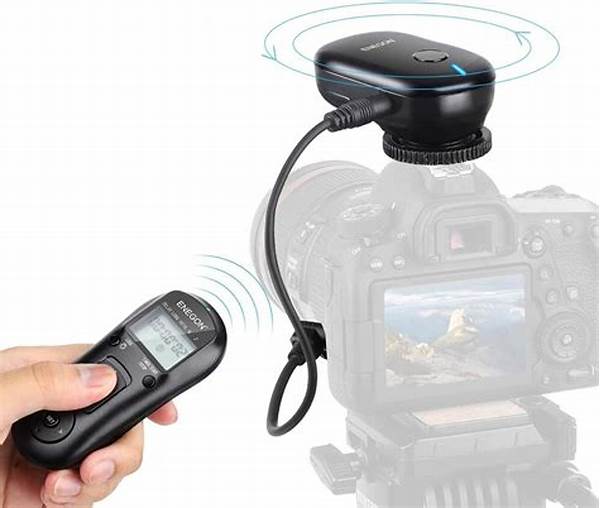Hey there, fellow photography lovers! Today, we are diving into the world of remote shutter release control—an essential tool for anyone who loves capturing the perfect shot without any hassle. Whether you’re shooting long exposures, self-portraits, or just want that flawless picture without camera shake, this nifty gadget is here to save the day.
Read Now : Strategies For Candid Portrait Sessions
Why You Need a Remote Shutter Release Control
Imagine you’re trying to capture the perfect sunset or a mesmerizing star trail. You’ve set up your camera on a tripod, adjusted your settings, and just as you’re about to press the shutter, you realize your hand wobble may ruin that dreamy shot. Enter the remote shutter release control—your new best friend in photography. This device allows you to trigger the camera from a distance, eliminating the risk of camera shake and helping you achieve sharper images. It’s like having an invisible helper, letting you focus entirely on composition and lighting.
Remote shutter release controls are not just about preventing blurs in long exposure shots. They also help in self-portraits and group photos where you want to be part of the action rather than behind the camera. Plus, they’re super handy for wildlife photography, allowing you to snap creatures in their natural habitat without startling them. Whether you’re an amateur enthusiast or a seasoned pro, integrating this tool into your gear collection is the way to go for enhanced creativity and flexibility.
Another reason to love the remote shutter release control is its versatility in the field. Many modern versions come with advanced features like timer settings, interval shooting for time-lapses, and even bulb mode for those extremely long exposures. This opens up a whole new realm of possibilities, transforming ordinary photography into extraordinary art. With all these advantages packed into a small device, the remote shutter release control is definitely a mini powerhouse worth owning.
Different Types of Remote Shutter Release Controls
1. Wired Remote Shutter Release
2. Wireless Remote Shutter Release
3. Infrared Remote Shutter Release Control
4. Radio Frequency Remote Shutter Release Control
5. Bluetooth Remote Shutter Release Control
Benefits of Remote Shutter Release Control
If you’re still pondering, “Do I really need one?” Let’s explore why a remote shutter release control can seriously amp up your photography game. First, it drastically reduces camera shake, giving you sharper, clearer images without the blur. Long exposure shots become a breeze, allowing you to showcase everything from silky waterfalls to dazzling light trails.
This tool isn’t just a one-trick pony. Having a remote shutter release control means you get to enjoy hassle-free self-portraits and group shots—perfect when you want everyone in the frame, including you! Plus, for those passionate about astrophotography, this gadget is a game-changer, allowing long exposures without any physical interference that might cause vibration.
Features to Look For in a Remote Shutter Release Control
1. Range
2. Compatibility
3. Additional Features
4. Build Quality
5. Ease of Use
Read Now : Studio Lighting For Profile Photos
6. Power Source
7. Portability
8. Affordability
9. Feedback Mechanism
10. Weather Resistance
How to Use a Remote Shutter Release Control
Getting started with your remote shutter release control is super simple and a lot of fun. Begin by plugging in or pairing your remote with the camera. Wired ones usually connect to a port, while wireless versions typically involve syncing. Once connected, test it out by snapping a few images to ensure everything’s working smoothly.
And there’s more to it than just pressing a button! Remote shutter release controls often come with extra features like timers and interval shooting. Experiment with them and see how they can elevate your photos from good to wow! For instance, try using the intervalometer setting for stunning time-lapse shots or exploring bulb mode for those extended night sky exposures.
So why not give it a shot (pun intended!)? With a remote shutter release control, you’ll discover whole new levels of creativity and precision in your photography. It’s like adding a massive boost of superpower to your camera gear, and trust me—once you start using one, you’ll wonder how you ever lived without it. Capture everything from breathtaking landscapes to intricate cityscapes with ease, and let your photos shine!
Advantages of Using Remote Shutter Release Control
Yo, picture snappers! Let’s talk about why using a remote shutter release control is like discovering the cheat code to flawless photos. First off, those long exposure shots we all drool over? This gadget makes them smooth as a jazz playlist. Say goodbye to unwanted vibrations.
Alright, fellow shutterbugs, here’s a quick roundup on why remote shutter release controls are the bee’s knees. They cut shake like a boss, making sure your images are sharper than a cat’s glare. Perfect for both spontaneous selfies and carefully planned shots, they’re the hidden gem in your photography toolkit.
Final Thoughts on Remote Shutter Release Control
In summary, the humble remote shutter release control packs a punch in the world of photography. It’s not just about snapping photos without touching the camera—it’s about freedom and creativity. Whether you’re capturing serene landscapes or bustling street scenes, this tool ensures your shots are always on point.
Beyond just functioning as a button, a remote shutter release control elevates your photography skills, providing you with the tools to push boundaries and explore new techniques. So next time you set up your tripod, remember: this little gadget could be the key to unlocking your creative potential and capturing those unforgettable moments.



